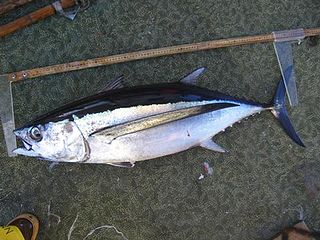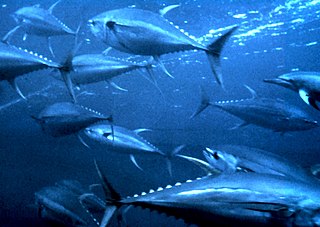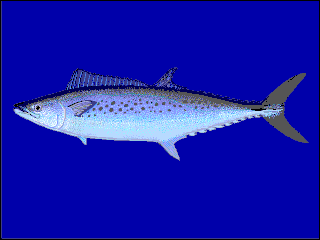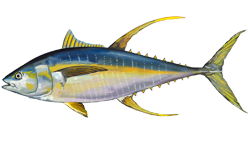
A tuna is a saltwater fish that belongs to the tribe Thunnini, a subgrouping of the Scombridae (mackerel) family. The Thunnini comprise 17 species across five genera, the sizes of which vary greatly, ranging from the bullet tuna up to the Atlantic bluefin tuna, which averages 2 m (6.6 ft) and is believed to live up to 50 years.

The albacore, known also as the longfin tuna, is a species of tuna of the order Scombriformes. It is found in temperate and tropical waters across the globe in the epipelagic and mesopelagic zones. There are six distinct stocks known globally in the Atlantic, Pacific, and Indian oceans, as well as the Mediterranean Sea. The albacore has an elongate, fusiform body with a conical snout, large eyes, and remarkably long pectoral fins. Its body is a deep blue dorsally and shades of silvery white ventrally. Individuals can reach up to 1.4 m in length.

The Atlantic bluefin tuna is a species of tuna in the family Scombridae. It is variously known as the northern bluefin tuna, giant bluefin tuna, and formerly as the tunny.

Almadraba is an elaborate and ancient technique for trapping and catching Atlantic bluefin tuna.

The Australian bonito, horse mackerel or little bonito, Sarda australis is a ray-finned fish of the family Scombridae and is found in eastern Australia and New Zealand. They swim at depths reaching depths of approximately 30 m (98 ft), in open water. Its length is commonly at around 40–45 centimetres (16–18 in) fork length and 1.8–2.3 kilograms (4.0–5.1 lb) weight. Its maximum length and weight are about 100 centimetres (39 in) and 9.4 kilograms (21 lb), respectively.

The frigate tuna, frigate mackerel or alagaduwa is a species of tuna, in the family Scombridae, found around the world in tropical oceans. The eastern Pacific population is now regarded as a separate species by some authorities, Auxis brachydorax.

The southern bluefin tuna is a tuna of the family Scombridae found in open southern Hemisphere waters of all the world's oceans mainly between 30°S and 50°S, to nearly 60°S. At up to 2.5 metres and weighing up to 260 kilograms (570 lb), it is among the larger bony fishes.

Psenes pellucidus, the bluefin driftfish, is a species of driftfish native to the Atlantic, Indian and Pacific oceans where it is found in deep waters to a depth of 1000 m. ). It is also present in low abundance since the mid-20th century in the western Mediterranean Sea which it most likely entered via the Strait of Gibraltar. It can reach a length of 80 cm TL.

Thunnus is a genus of ocean-dwelling, ray-finned bony fish from the mackerel family, Scombridae. More specifically, Thunnus is one of five genera which make up the tribe Thunnini – a tribe that is collectively known as the tunas. Also called the true tunas or real tunas, Thunnus consists of eight species of tuna, divided into two subgenera.

The Pacific bluefin tuna is a predatory species of tuna found widely in the northern Pacific Ocean, but it is migratory and also recorded as a visitor to the south Pacific.

The bullet tuna is a species of tuna, in the family Scombridae, found circumglobally in tropical oceans, including the Mediterranean Sea, in open surface waters to depths of 50 m (164 ft). The population of bullet tuna in the Eastern Pacific was classified as a subspecies of A. rochei, A. rochei eudorax, but some authorities regard this as a valid species Auxis eudorax. Its maximum length is 50 centimetres (20 in).

The Australian spotted mackerel is a species of fish in the family Scombridae. Common fork length ranges between 50 and 80 cm. Specimens have been recorded at up to 104 cm in length, and weighing up to 10.2 kg. It is found in the western Pacific, along the northern coast of Australia, from the Abrolhos Islands region of Western Australia to Coffs Harbour and Kempsey in central New South Wales. It is also found in southern Papua New Guinea from Kerema to Port Moresby. It feeds largely on fishes, particularly anchovies and sardines, with smaller quantities of shrimps and squids. It is sometimes confused with Japanese Spanish mackerel, S. niphonius. Conservation status of the species has been evaluated as Near Threatened by the IUCN. This species was described in 1980 and was previously confused with the Japanese Spanish mackerel of the north western Pacific but S. munroi has a different visceral structure, more vertebrae and fewer gill rakers.
The broadbarred king mackerel or grey mackerel is a species of fish in the family Scombridae found in tropical waters of the western Pacific, along the northern coast of Australia and the southern coast of Papua New Guinea, from Shark Bay, Western Australia to northern New South Wales, in waters from the surface down to 100 m (330 ft). Specimens have been recorded at up to 120 cm in length, and weighing up to 10 kg. They are pelagic predators, feeding on small fishes such as sardines and herring.

The Queensland school mackerel is a species of fish in the family Scombridae. It is found in tropical waters of the western Pacific, largely confined to inshore coastal waters of southern Papua New Guinea and northern and eastern Australia, from Shark Bay and Onslow, Western Australia to Sydney, New South Wales. Queensland school mackerel commonly occur in waters down to 100 m, usually to 30 m, in depth. Specimens have been recorded at up to 100 cm in length, and weighing up to 12.2 kg.

Euthynnus affinis, the mackerel tuna, little tuna, eastern little tuna, wavyback skipjack tuna, kawakawa, or tongkol komo is a species of ray-finned bony fish in the family Scombridae, or mackerel family. It belongs to the tribe Thunnini, better known as the tunas. This is an Indo-Pacific species which is found from the Red Sea to French Polynesia.

Euthynnus lineatus, the black skipjack tuna or black skipjack, is a species of ray-finned bony fish in the family Scombridae. It belongs to the tribe Thunnini, better known as the tunas.

The leaping bonito is a species of saltwater finfish from the Scombridae (Mackerel) family. Scombridae includes such tribes as the mackerels, tunas, and bonitos – of the latter of which, the Sardini tribe, this fish is a member. It is the only member of the genus Cybiosarda, which is therefore called a monotypic taxon. Since the bonitos and tunas are close relatives, this fish has variously been referred to by such other common names as Australian tuna, striped bonito, and Watson's bonito.
Several fish species are known as northern bluefin tuna, including:

Thunnus (Neothunnus) is a subgenus of ray-finned bony fishes in the Thunnini, or tuna, tribe. More specifically, Neothunnus is a subgenus of the genus Thunnus, also known as the "true tunas". Neothunnus is sometimes referred to as the yellowfin group, and comprises three species:

Thunnus (Thunnus) is a paraphyletic subgenus of ray-finned bony fishes in the Thunnini, or tuna, tribe. More specifically, Thunnus (Thunnus) is a subgenus of the genus Thunnus, also known as the "true tunas". Thunnus (Thunnus) is sometimes referred to as the bluefin group and comprises five species:



















